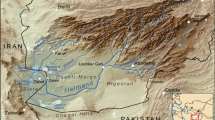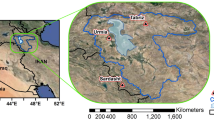Abstract
For the very first time, the mesoscale circulation patterns and synoptic-dynamic structure of the atmospheric systems that led to the dust emission to the south coast region of Caspian Sea (SCRCS) were identified and classified using the region synoptic stations’ observations of 2005–2013. Satellite measurements and images, NCEP/NCAR reanalysis data, and Weather Research and Forecasting (WRF) model coupled with Chemistry (WRF-CHEM) model products were also used in this study. Results showed that in 49 % of cases, cyclonic circulations over the Middle East deserts were the main transporter of dust particles into the atmosphere where then transferred to the SCRCS by southerly winds over the Alborz mountains in the lower troposphere and by westerly waves in the middle and upper troposphere. During the warm seasons, the surface heating lead to the development of mesoscale thermal low pressures over the hot deserts on the eastern regions of the Caspian Sea, like Turkmenistan and Qura Qum. Those heat lows were responsible for the 38 % of the occurred events. Turbulence and instabilities in the lower troposphere were identified as the second important dust emitter to the atmosphere where those dust particles transported to the SCRCS with the strong northeasterly wind. The third pattern by 13 % of cases was belonging to the mesoscale thermal low pressure that was developed over the arid regions of Iran like Dasht-é-Kavir. Because of the nature of the turbulence in the lower troposphere and heat lows, the ascent of dust particles by these two mechanisms was limited to a shallow layer in the troposphere. The results of simulation with the WRF-CHEM model, analysis of moderate resolution imaging spectroradiometer (MODIS) images, and spatial zoning of atmospheric optical depth (AOD) confirmed the results of the synoptic study.




















Similar content being viewed by others
Notes
United Nations Environment Programme
Final (Operational Global Analysis data)
NCAR Command Language
References
Albrecht BA (1989) Aerosols, cloud microphysics, and fractional cloudiness. Science 245:1227–1230
Alizadeh-Choobari O, Zawar-Reza P, Sturman A (2012) Feedback between windblown dust and planetary boundary-layer characteristics: sensitivity to boundary and surface layer parameterizations. Atmos Environ 61:294–304
Alizadeh-Choobari O, Zawar-Reza P, Sturman A (2014) The “wind of 120 days” and dust storm activity over the Sistan Basin. Atmos Res 143:328–341
Azimi Dobakhshari N (2006) Gilan natural geograghy. Gilan Culture and Civilization Encyclopedia. ILYA culture publication
Charlson RJ, Schwartz SE, Hales JM, Cess RD, Coakley JA, Hansen J, Hofmann DJ (1992) Climate forcing by anthropogenic aerosols. Science 255:422–430
Desouza ND, Simon B, Qureshi MS (2011) Evolutionary characteristics of a dust storm over Oman on 2 February 2008. Meteorog Atmos Phys 114:107–121
Fakhraee M, Hajjam S. Meshkatee AH (2012) Dynamic analyze of dust storm in southwest of Iran (case study, Feb 2005). 1th desert national conference
Ganji M.H, (1995) Gilan climate. Gilan book. IRAN 3:18–22
Grell GA, Peckham SE, Schmitz R, McKeen SA, Frost G, Skamarock W, Eder B (2005) Fully coupled chemistry within the WRF model. Atmos Environ 39(37):6957–6975
Haustein KC, Pe’rez J, Baldasano M, Muller D, Tesche M, Schladitz A, Esselborn M, Weinzierl B, Kandler K, von Hoyningen-Huene W (2009) Regional dust model performance during SAMUM 2006. Geophys Res Lett 36:L03812. doi:10.1029/2008GL036463
Kaufman YJ, Fraser RS (1983) Light extinction by aerosols during summer air pollution. J Clim Appl Meteorol 22:1694–1725
Khoshhal J, Mousavi SH, Kashki A (2012) Synoptic analysis of Ilam dust storms (1987-2005). Geography and Environmental Planning Journal 46(2):5–10
Kutiel H, Furman H (2003) Dust storms in the Middle East: sources of origin and their temporal characteristics. Environmental Problems Affecting Health
Liu Y, Dongxu Y, Wenzhong C, and Hua Z (2010) Measurements of Asian dust optical properties over the Yellow Sea of China by shipboard and ground-based photometers, along with satellite remote sensing: A case study of the passage of a frontal system during April 2006. J. of Geophysical Research 115: D00K04 doi:10.1029/2009JD012684
Maghrabi AH (2011) The impact of the March 10, 2009 dust storm on meteorological parameters in central Saudi Arabia. World Renewable Energy Congress, Linkoping, pp. 719–723
Mashayekhi R, Irannejad P, Aliaakbari-Bidokhti AA (2010) The simulation of aerosols and its radiation forcing using the new coupled system of aerosol HAM model with the weather research and forecasting (WRF) model. J Earth and Space 37(2):91–107
Masoodian A, Kaviani MR (2008) Iran Climatology. Esfahan university publication
Mofidi A, Jafari S (2011) Study of atmospheric regional circulation role over middle-east in summer-time dust storm in southwest of Iran. J Geographic Study of Arid Regions 2(5):17–45
Mofidi A, Kamali S, Zarrin A (2013) Evaluation of the RegCM4 model coupled with dust module on identification of dust storm features over the Sistan region. 1th national conference of climatology. Kerman University Iran
Orlovsky N, Orlovsky L, Durdyev A (2005) Dust storms in Turkmenistan. Arid Environ 60(1):83–97
Rezazadeh M, Irannejad P, Shao Y (2013) Climatology of the Middle East dust events. Aeolian Res 10:103–109
Sisipoor M, Meshkatee AH, Ranjbar Saadat Abadi A (2010) Study of dust events synoptic patterns over Hormozgan province. National Conference of Health, Environment and Sustainable Development.
Speer MS (2013) Dust storm frequency and impact over eastern Australia determined by state of Pacific climate system. Weather and Climate Extremes 2:16–21
Tavoosi T, Khosravi M, Raeespoor K (2010) Synoptic analyze of dust system in Khozestan province. J Geography and Development 20:97–118
Tegen I, Heinold B, Todd M, Helmert J, Washington R, Dubovik O (2006) Modelling soil dust aerosol in the Bodele depression during the BoDEx campaign. Atmos Chem Phys 6:4345–4359
Torres O, Bhartia PK, Herman JR, Sinyuk A, Ginoux P, Holben B (2002) A long-term record of aerosol optical depth from TOMS observations and comparison to AERONET measurements. J Atmos Sci 59(3):398–413
Towmey S (1991) Aerosols, clouds and radiation. Atmos Environ Part A 25:2435–2442
UNEP, 2010. United Nations Environment Program Annual Report: pp: 21–23
Wang YS, Yao L, Wang LL, Liu Z, Ji, D, Tang G, Zhang J, Sun Y, Hu B, and Xin J (2014) Mechanism for the formation of the January 2013 heavy haze pollution episode over central and eastern China. Sci China Earth Sci 57:14–25
Wilkerson WD (1991) Dust and sand forecasting in Iraq and adjoining countries. USAF Environmental Technical Applications Center. pp: 72
WMO (1994) Report of the WMO workshop on the measurements of atmospheric optical depth and turbidity. World Meteorological Organization Report GAW-101:13
World Health Organization (WHO). 2011. The top 10 most air polluted cities in the world, written by M. L. Goldberg, UN Dispatch, 26 Sep. 2011
Wu XJ, Zheng XD, Liam XL, Liu JT, Kang L, Jiang XG (2004) Analyses on the characteristics and pattern classification of East-Asia spring dust storms by using the meteorological satellite images clim. Environ Res 1:1–13
Zhao TXP, Ackerman S, Guo W (2010) Dust and smoke detection for multi-channel imagers. Int J Remote Sens 2:2347–2367
Zhao TXP (2012) Asian dust detection from the satellite observations of moderate resolution imaging spectroradiometer (MODIS). Aerosol Air Qual Res 12:1073–1080
Zolfaghari H(2011) Synoptic analysis of dust systems in the west of Iran during 2004–2008. J. Geography and Environmental Managing 22(43)
Zolfaghari H, Abedzadeh H (2005) Synoptic analysis of dust systems in the west of Iran. J Geogr Dev (Iran) 6:173–188
Author information
Authors and Affiliations
Rights and permissions
About this article
Cite this article
Negah, S., Mesakatee, AH., Hajjam, S. et al. Investigation of the atmospheric mesoscale circulation patterns and their simulation with WRF-CHEM model of the dust storm occurrence over the southern coast of the Caspian Sea. Arab J Geosci 9, 649 (2016). https://doi.org/10.1007/s12517-016-2670-9
Received:
Accepted:
Published:
DOI: https://doi.org/10.1007/s12517-016-2670-9




